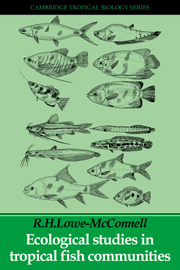9 - Demersal fish studies
Published online by Cambridge University Press: 07 May 2010
Summary
Factors affecting demersal fishes
Information on the ecology of demersal fishes comes mainly from two sources: (1) line fishing over hard substrates, old dead coral, rock or other rough ground; and (2) trawl fishing on the continental shelves where the shelf is wide and there are suitable deposits of sand or firm mud. Some Neritic pelagic fishes may also be taken in the trawls, particularly fish which have the habit of forming demersal schools, as do carangid jacks and scads (Caranx, Trachurus), and some clupeids such as Sardinella which congregate near bottom depressions by day moving up to feed by night. Many of the rough–ground fishes caught by lines may also rest some way above the bottom but feed on the bottom, often by night.
Shelf faunas are greatly affected by the width of the shelf and nature of bottom deposits, by oceanographical conditions (salinity, clarity of water, temperature, water movements and so on), and by the history of the oceans and possibilities of colonization from neighbouring areas. The continental shelf may be over 100 km wide, sloping gradually to about 100 m deep before it falls away steeply into deep water (as off Guyana). The type of bottom is of prime importance in controlling the distribution of demersal fishes. Soft mud, sand, hard rock and coral, each has a characteristic community of fishes and of invertebrates so important as fish food.
- Type
- Chapter
- Information
- Ecological Studies in Tropical Fish Communities , pp. 212 - 225Publisher: Cambridge University PressPrint publication year: 1987



